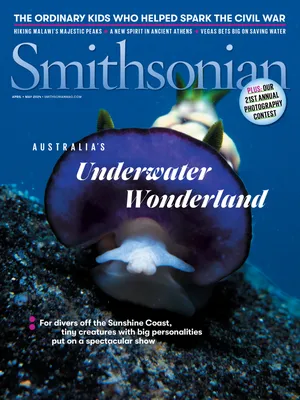OFFICE OF THE SECRETARY OF THE SMITHSONIAN
An Appreciation of the Volunteers Who Devote Their Time to the Smithsonian
Whether fielding questions from visitors or digging for answers behind the scenes, volunteers help the museums thrive
:focal(1000x667:1001x668)/https://tf-cmsv2-smithsonianmag-media.s3.amazonaws.com/filer_public/04/6f/046f63ef-6bea-4c74-8bb2-fd3f51d8c2f5/aprmay2024_j01_secretary.jpg)
Now, as Secretary, I remain humbled by the work and knowledge of our volunteers; they are essential to our operations. More than 3,000 volunteers work on-site. Tens of thousands more contribute from their homes.
An example close to my heart is that of Jennie Caughran, who has helped transcribe and review more than 140,000 pages of the Freedmen’s Bureau Records at the National Museum of African American History and Culture from her home in Texas. These documents unlocked my own family lineage: In them, I found a record of Candis Bunch, an enslaved woman in North Carolina and my great-great-grandmother. It was surreal and unforgettable to come across her name in my research—and it is an experience that Caughran’s work will make possible for many others.
Joseph Gregor, a volunteer for the Natural History Museum, donated so much time to recovering a fossil that the newly discovered species was named in his honor. The Opisthiamimus gregori is a six-inch-long bug-eating reptile that once inhabited Jurassic-age Wyoming. Gregor freed its skeleton by chiseling through a stone block, a process so delicate that it consumed hundreds of hours.
This year, Donna DeCorleto will celebrate 50 years as a Smithsonian volunteer. She serves in our Office of Visitor Services and remembers having to answer phones in our call center before the internet: She fielded myriad questions, from how to get a boa constrictor out of a washing machine to where Margaret Truman might set the scene of the crime in her book Murder in the Smithsonian.
DeCorleto, whose maternal grandparents immigrated to the United States from Poland, said they would be so proud to have a granddaughter who was able to donate time to something like the Smithsonian. All these years later, we are very lucky to have her working on our behalf.
I have often said that museums are not community centers, but at their best they are at the center of their community. I am so grateful for the thousands of people who volunteer their time and help the Smithsonian live up to that ideal.
/https://tf-cmsv2-smithsonianmag-media.s3.amazonaws.com/filer_public/57/50/5750bccd-ab23-49c2-be0c-b69b162be0a1/jennie_caughran_at_nmaahc.jpg)
